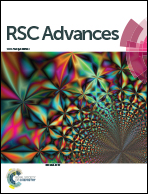Chemical and thermal properties of VO2 mechanochemically derived from V2O5 by co-milling with paraffin wax†
Abstract
A novel mechanochemical reduction process of V2O5 to VO2 was established by milling with paraffin wax (PW, average molecular weight 254–646), serving as a reductant. The reduction progressed with increasing milling time and mass ratio V2O5 : PW (MRVP). The mechanochemically derived VO2 became phase pure after milling for 3 h with an MRVP of 30 : 1 and exhibited a reversible polymorphic transformation between tetragonal and monoclinic phases at around 53–60 °C and 67–79 °C during heating and cooling, respectively. The latent heat was above 20 J g−1 in both processes, being superior to those of commercial VO2. Doping of starting V2O5 with Cr, Mo or W at 1 at% in the form of oxide did not increase the latent heat. This is another difference from the conventionally prepared doped VO2. These anomalous heat storage properties of mechanochemically derived VO2 were discussed mainly on the basis of X-ray photoelectron spectroscopy V2p3/2 peaks combined with ion etching. The observed relatively high heat storage capacity of undoped VO2 is primarily ascribed to the abundance of V4+ ionic states introduced during milling with PW, which were stabilized with simultaneously introduced structural degradation throughout the entire particles. The possible role of a remaining small amount of PW was also discussed.



 Please wait while we load your content...
Please wait while we load your content...